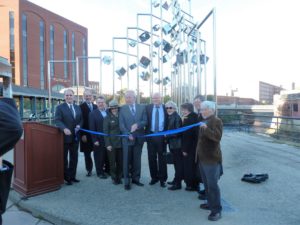‘Pawtucket Prism’ Renewal Is a Classic Lowell Partnership Success
Ribbon-cutting at the restored “Pawtucket Prism” (web photo courtesy of Marie Sweeney). From left, Jay Linnehan, Steve Joncas, Paul Marion, Celeste Bernardo, Mayor Edward Kennedy, Jim Campbell, Nancy Donahue, Belinda Juran, Evan Schapiro, and artist Michio Ihara.
About 75 people yesterday attended the re-dedication of the “Pawtucket Prism” sculpture by Michio Ihara of Concord, Mass., at the corner of Pawtucket Canal and Concord River “streets.” Positioned on a small waterfront plaza between the UMass Lowell Inn & Conference Center (ICC) and Cowan Building of Middlesex Community College, this kinetic sculpture made of stainless steel had been installed in 1987 as a combination water-and-wind driven artwork whose metal cubes swayed between steel poles and reflected sunshine the way the surface of water glints and sparkles on a bright day. After some years, the plumbing system broke down and the water feature stopped working. And 30 years of living took a toll on the original golden cubes.
Thanks to Steve Joncas of the Greater Lowell Community Foundation board of directors, an effort to renovate the artwork began in early 2015. He approached me because of the university connection and my experience with the project at the start, and then gained the backing of the National Park Service (NPS). Michio was enthusiastic about the opportunity to re-imagine and restore the sculpture. In classic Lowell fashion, other community partners and individuals offered to help: UMass President Marty Meehan pledged support, City Manager Kevin Murphy delivered resources, Nancy Donahue and Evan Schapiro & Belinda Juran contributed, the university and NPS provided funds, the Aramark company at the ICC assisted during the renovation, and more. The Community Foundation won a highly competitive grant from the National Foundation for the Arts thanks to George Nugent of its staff. The pieces came together and people did their jobs gladly.
The restoration of the sculpture is phase one of the project, which has a follow on phase involving improvements to the plaza and grassy area. Early in the planning process the Foundation contacted landscape architect and Lowell native Alison Duncan for design advice. Phase two will likely include new plantings, lighting improvements, enhanced grounds, and the addition of seating, all of which should make the area more appealing as a public space for enjoying the artwork, water-side views, white water rafting sights, and small cultural events. Thousands of people regularly move around the area, including college students and people walking from the City garage to shows at the Auditorium and MRT. Organizers of the Waterways Vitality project see the Lower Locks canal complex as one of the primary activity sites.
Everyone attending yesterday’s ribbon-cutting felt good about bringing the sculpture back to life. The new mirror-finished steel cubes are dazzling to see. With a new spinning mechanism, the lighter weight cubes move easily. Zen Associates landscape designers of Woburn provided a refinished base with small black stones set in white mortar to complete the new look. “Pawtucket Prism” is the only wind-activated artwork in the Lowell Public Art Collection. Its style is consistent with work that Michio Ihara has in place around the country and the world, from New York City to Japan to New Zealand.
The Community Foundation’s executive director Jay Linnehan said he is encouraged by the way Lowell people are taking care of unfinished business these days, particularly from an arts standpoint. He cited Community Teamwork Inc. for the renewal of the large Irish/Acre mural on Worthen Street and the Acre Coalition (ACTION) and its partners for reinventing Decatur Way between Salem and Merrimack streets, a desolate, overgrown alley that is now alive with creative elements.
